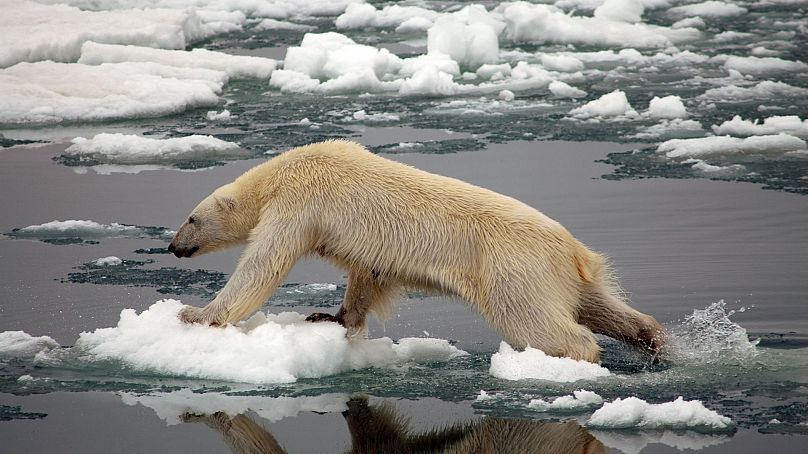"Dream, Dream, Dream! Conduct these dreams into thoughts, and then transform them into action."
- Dr. A. P. J. Abdul Kalam
"Dream, Dream, Dream! Conduct these dreams into thoughts, and then transform them into action."
- Dr. A. P. J. Abdul Kalam
8 Apr 2024
In an experiment, US scientists attempted to temporarily chill Earth by reflecting part of the Sun's radiation back into space. This experiment is being conducted at a critical juncture, as humankind has been unable to keep global warming at a reasonably safe level. The hottest year ever recorded was 2023. Since many countries are failing to keep global temperatures at 1.5 degrees Celsius over preindustrial levels, scientists are looking for novel solutions that may have an impact rapidly. In a similar spirit, US scientists have attempted to briefly chill Earth by reflecting part of the sun's rays into space.
Addressing Global Warming ~

A Polar Bear Struggles to Cross Melting Lake ~ Are We Too Late!
( Source: Google Images)
The rate of change in the climate is quickening, according to research released last year by former NASA chief climate scientist James Hansen and colleagues. The ocean's heat content, which stores a large portion of Earth's trapped energy, is growing more quickly than previously, according to a second research. Heat waves are becoming more frequent, which is one of the most obvious effects of global warming. According to a recent study, climate change is causing massive heat waves to spread more slowly throughout the world and to bake more people longer by raising temperatures over more regions. This study entirely examines how variations in weather patterns contribute to the spread of heat waves. Heat waves are spreading less swiftly over most but not all of the continents as a result of weakened atmospheric waves like the jet stream that carry weather systems around.
About The Experiment ~

Seasons are Changing at a Rapid Pace Tho?
( Source: Google Images)
In an experiment, US scientists attempted to temporarily chill Earth by reflecting part of the Sun's radiation back into space. This experiment is being conducted at a critical juncture, as humankind has been unable to keep global warming at a reasonably safe level. Atop a defunct aircraft carrier in San Francisco Bay, researchers from the University of Washington used a snow-machine-like contraption on April 2 to quickly release a mist of salt aerosols into the open.
Under a covert program known as Coastal Atmospheric Aerosol Research and Engagement, or CAARE, the study was conducted. It was proposed to establish a fleet of 1,000 ships that would traverse the whole world while launching saltwater droplets into the sky in an attempt to deflect solar heat and chill Earth. The process of returning solar energy to space is known as cloud brightening, sometimes known as solar radiation manipulation or solar geoengineering. It causes clouds to get brighter, which lowers local temperatures by having them reflect a small amount of incoming sunlight.
To do this test, scientists must spray quadrillion of these particles each second, with each particle being 1/700th the thickness of a human hair. If the technology works, it will place many devices above oceans with their faces directed toward the sky in an attempt to reduce the rising sea temperatures.
A Concept: Cloud Brightening Already Exists ~
According to Sarah Doherty, manager of the University of Washington's marine cloud brightening program and atmospheric scientist, everyday occurrences of marine cloud brightening already take place. According to The New York Times, ship tracks are the brightening clouds that are left behind by ship exhaust particles as they traverse the oceans. She claims that up until recently, around 5% of the heat produced by greenhouse gases was offset by the brightness of the clouds brought on by ship tracks.
Strangely, as environmental regulations and advances in technology have reduced the amount of pollution that ships discharge, the inadvertent cloud brightening and concomitant cooling are lessening. Dr. Doherty recommended the use of sea salts as part of a deliberate effort to brighten marine clouds. She informed the outlet that further research was necessary to rule out any possible negative consequences. Reduced precipitation in some locations and increased precipitation in others might be another way that cloud brightening alters precipitation patterns. Nonetheless, she maintained that if society does need these technologies, it is crucial to ascertain their feasibility and workings.
It's The Responsibility Of Humans To safeguard Our Planet ~ There Is Planet B For Now!
Technology-nature cooperation provides countless opportunities to revitalize the environment. Now, the task at hand is to expand this effort beyond a few test locations to every location where we are engaged in environmental protection. More than technology, what we need is a fundamental shift in perspective and an appreciation of the importance that biodiversity and the environment play in our daily lives and companies. The way we now create, consume, and power our lives will eventually overload and collapse weather systems, forests, and seas. Climate change, overexploitation, pollution, and catastrophic biodiversity loss are being caused by unsustainable agriculture, fisheries, mining, infrastructural development, and energy. Although the effects on the natural world are becoming more noticeable, there are also actual repercussions for humans. The evidence is more visible than ever, ranging from the lack of food and water to the state of the air we breathe. However, we are frequently missing the connection. We require an equally historic cultural revolution in the way we relate to the earth in addition to the technology revolution.